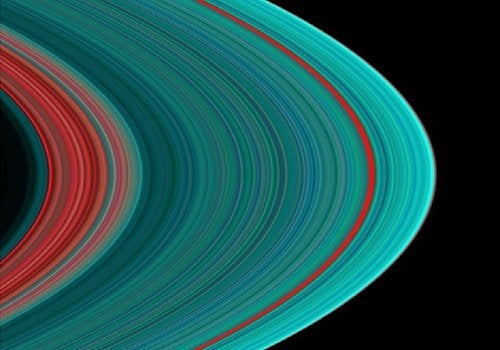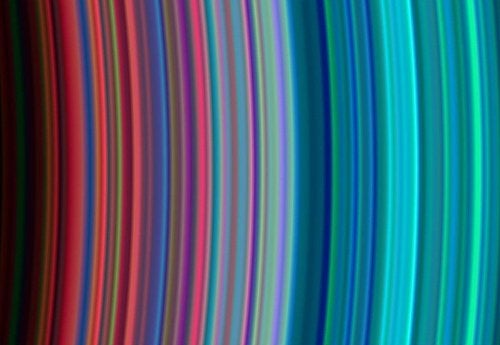Scientists with the Cassini-Huygens mission released the best-ever ultraviolet views of Saturn’s rings today, taken as the spacecraft swung into orbit on June 30. The images, which show clear compositional differences between the planet’s bright A, B, and C rings, provide clues about the processes that created and maintain the solar system’s largest and most complex ring system.
Joshua Colwell and Larry Esposito, both researchers at the Laboratory for Atmospheric and Space Physics at the University of Colorado in Boulder, examined the rings using the Ultraviolet Imaging Spectrograph, or UVIS, a $12.5 million instrument riding on Cassini. Colwell created the color-enhanced images of the rings based on spectra obtained by the UVIS as the spacecraft entered Saturn orbit. Esposito, who discovered the F ring around Saturn in 1979 using Pioneer 11 data, leads the Cassini UVIS team.
The UVIS instrument can see features up to 60 miles (100 kilometers) across. That translates to about ten times the resolution of a similar instrument on the Voyager 2 spacecraft, which flew past Saturn in 1981 and, until Cassini’s arrival, was the most recent spacecraft to visit the ringed planet.
The ring system begins from the inside out with the D, C, B, and A rings, followed by the fainter and more recently discovered F, G, and E rings. Sparser ringlets, likely made of “dirtier” and possibly smaller particles, appear reddish in the image, while denser, icier ringlets look turquoise. Particles in the Cassini Division, as well as those in an area known as the Encke Gap, appear to contain more dirt than ice.
These results complement findings by another Cassini instrument — the Visual and Infrared Mapping Spectrometer, or VIMS — showing that particles between the bright rings seem remarkably similar to the dark material scientists saw on Saturn’s moon, Phoebe. These dark particles refuel the theory that the rings might be the remnants of a moon. VIMS also showed a higher proportion of dirt in the F ring.
“The Phoebe-like material is a big surprise,” said Linda Spilker, deputy project scientist for the Cassini-Huygens mission at NASA’s Jet Propulsion Laboratory (JPL) in Pasadena, California, last week. “What puzzles us is that the A and B rings are so clean and the Cassini Division between them appears so dirty.”
One possibility is that the dirtier particles in some parts of the rings came from moons with a more Pheobe-like composition, while the brighter portions of the rings came from more icy bodies. Or perhaps meteorite collisions brought dark material to all the rings, but Cassini’s instruments are detecting this matter only where the rings have the least amount of icy particles — the scenario currently favored by some scientists.











